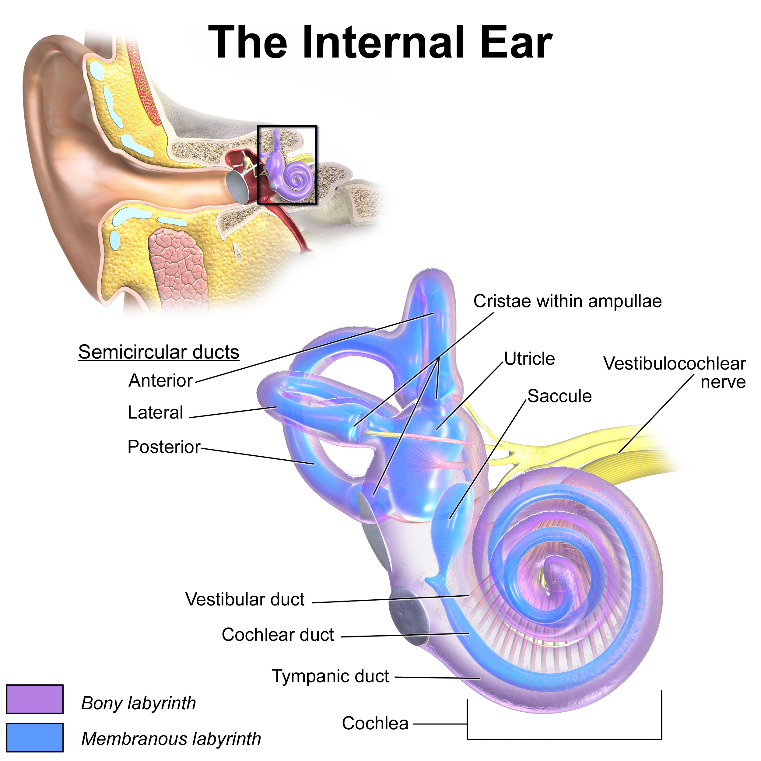
The membranous labyrinth is concerned with
(A) Hearing
(B) Equilibrium
(C) Both A and B
(D) None of the above
Answer
486.9k+ views
Hint: Membranous labyrinth is a part of the human ear. It is present within the bony labyrinth. Labyrinth is also known as inner ear. Ears perform two sensory functions, namely hearing and maintenance of body balance (both static and dynamic). Hair cells are the auditory receptors and ampullaris and macula are the balancing receptors.
Complete step by step answer:
Each ear is differentiated into three regions, namely external ear, middle ear and internal ear. The external ear consists of pinna and external auditory canal, which helps in passing the sound vibrations to the middle ear. The middle ear consists of an ear drum (tympanic membrane), three ossicles (malleus, incus and stapes). Ear ossicles mainly help in increasing the efficiency of transmission of sound waves.
The inner ear comprises circular canals called cochlea and vestibular apparatus. The inner ear is usually fluid filled and also known as labyrinth. Labyrinth can be differentiated into two regions, namely bony and membranous labyrinth. Bony labyrinth consists of a series of channels into which a membranous labyrinth is present, which is surrounded by perilymph. Inside the membranous labyrinth, the cavity is filled with endolymph.
The coiled portion of labyrinth otherwise known as cochlea consists of reissner’s membrane and basilar membrane.
Organ of corti is present on the basilar membrane, which contains hair cells (auditory receptors). Vestibular apparatus consists of semicircular canals and otolith organs. The otolith organ consists of saccule and utricle. The semicircular canals contain crista ampullaris and saccule & utricle contains macula. Ampullaris and macula are the balancing receptors responsible for maintenance of body balance. The receptors for hearing (hair cells) and balance (ampullaris and macula) are present on membranous labyrinth, and hence it is concerned with both the functions.

Hence the correct answer is option(C)
Note: Remember, in the inner ear the membranous labyrinth, present inside the bony labyrinth contains receptors for both hearing and equilibrium. Both static and dynamic equilibrium are maintained by the balancing receptors. Bony labyrinth is surrounding the membranous labyrinth and it is helpful in protecting the inner soft membranes.
Complete step by step answer:
Each ear is differentiated into three regions, namely external ear, middle ear and internal ear. The external ear consists of pinna and external auditory canal, which helps in passing the sound vibrations to the middle ear. The middle ear consists of an ear drum (tympanic membrane), three ossicles (malleus, incus and stapes). Ear ossicles mainly help in increasing the efficiency of transmission of sound waves.
The inner ear comprises circular canals called cochlea and vestibular apparatus. The inner ear is usually fluid filled and also known as labyrinth. Labyrinth can be differentiated into two regions, namely bony and membranous labyrinth. Bony labyrinth consists of a series of channels into which a membranous labyrinth is present, which is surrounded by perilymph. Inside the membranous labyrinth, the cavity is filled with endolymph.
The coiled portion of labyrinth otherwise known as cochlea consists of reissner’s membrane and basilar membrane.
Organ of corti is present on the basilar membrane, which contains hair cells (auditory receptors). Vestibular apparatus consists of semicircular canals and otolith organs. The otolith organ consists of saccule and utricle. The semicircular canals contain crista ampullaris and saccule & utricle contains macula. Ampullaris and macula are the balancing receptors responsible for maintenance of body balance. The receptors for hearing (hair cells) and balance (ampullaris and macula) are present on membranous labyrinth, and hence it is concerned with both the functions.

Hence the correct answer is option(C)
Note: Remember, in the inner ear the membranous labyrinth, present inside the bony labyrinth contains receptors for both hearing and equilibrium. Both static and dynamic equilibrium are maintained by the balancing receptors. Bony labyrinth is surrounding the membranous labyrinth and it is helpful in protecting the inner soft membranes.
Recently Updated Pages
Master Class 11 Economics: Engaging Questions & Answers for Success

Master Class 11 Business Studies: Engaging Questions & Answers for Success

Master Class 11 Accountancy: Engaging Questions & Answers for Success

Master Class 11 English: Engaging Questions & Answers for Success

Master Class 11 Computer Science: Engaging Questions & Answers for Success

Master Class 11 Maths: Engaging Questions & Answers for Success

Trending doubts
State and prove Bernoullis theorem class 11 physics CBSE

1 ton equals to A 100 kg B 1000 kg C 10 kg D 10000 class 11 physics CBSE

State the laws of reflection of light

One Metric ton is equal to kg A 10000 B 1000 C 100 class 11 physics CBSE

1 Quintal is equal to a 110 kg b 10 kg c 100kg d 1000 class 11 physics CBSE

Difference Between Prokaryotic Cells and Eukaryotic Cells




